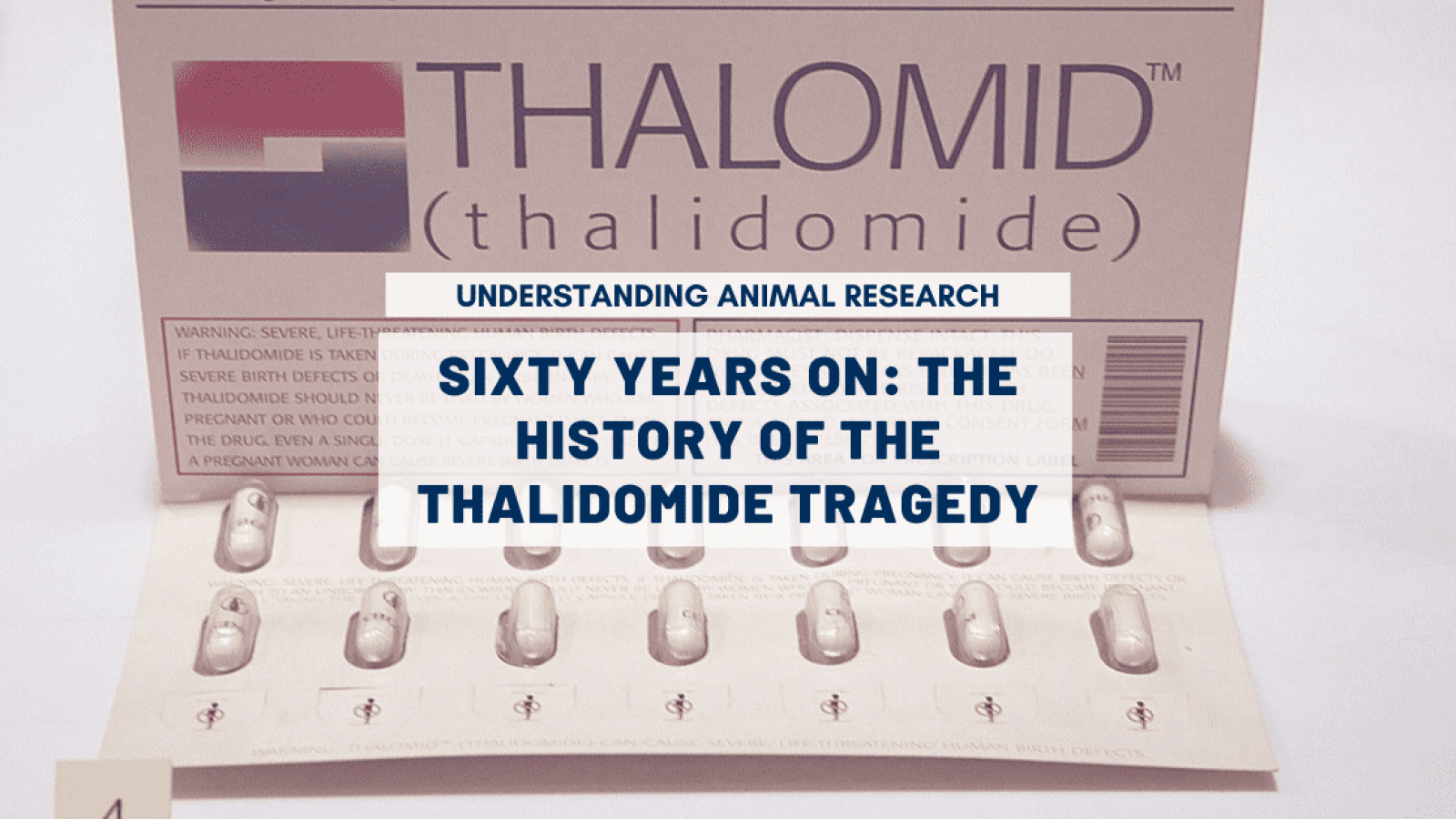Sixty years ago (2 December 1961) the sedative drug thalidomide was withdrawn from use in the UK. After being on the market for five years as a treatment for morning sickness in pregnant women, it had finally been established that the medicine was responsible for babies being born with underdeveloped arms and legs and other malformations.
It’s fair to say that no other medicine has had more of an effect on the regulatory requirements for safety-testing potential drugs before they go anywhere near a human being. The thalidomide tragedy was responsible for the creation of the UK’s Committee on the Safety of Drugs and the Medicines Act of 1968.
Those opposed to the use of animals in medical research claim that thalidomide is an example of a medicine that was ‘tested as safe in animals’ but then went on to harm humans. The real story reveals that the reason thalidomide damaged so many babies was not because animal testing is ineffective but because the tests that were done were nowhere near stringent enough: it was never tested on pregnant animals before it was given to pregnant humans. When thalidomide was finally – and far too late – tested on pregnant rats and rabbits, damage was seen in their embryos and offspring, supporting the theory that it was the cause of malformations in babies. Over the following ten years, thalidomide was shown to damage the foetus in seven other species of small mammal and eight species of monkey. [1]
So how did this drug, untested in pregnant animals, come to be given to pregnant mothers? And how can we be sure that this sort of tragedy won’t happen again?
Thalidomide was developed in Germany in the 1950s as a sedative and was tested in several (non-pregnant) animal species and then in humans. The animal results seemed to show that even very high doses were not harmful. In human patients it seemed that the new medicine had remarkably few side effects and was well-tolerated by people taking it, except for those given high doses, who complained of sleepiness, giddiness and constipation. This suggested that it would be a good alternative to existing sedatives such as phenobarbitone.
However, it appears that the studies published by the company developing the drug, Chemie Grünenthal, were not rigorous: there was no placebo group and no indication of how long treatment had gone on for. None of the studies were double-blind. There was also no measurement of how much thalidomide there was in the blood or tissue of the patients taking it. Widukind Lenz, one of the doctors who investigated thalidomide in the aftermath of the tragedy, said: “The papers published in 1956 … on animal experiments and … on clinical experiences with thalidomide have so little scientific value that in my opinion they should not have been accepted for print.”
Thalidomide was marketed in several countries and was called Distaval in the UK. It was prescribed as a totally safe sedative and was used in treatments for flu and also the morning sickness and insomnia associated with pregnancy, despite the fact that no safety testing had been done on pregnant animals. It is sometimes argued that, in the 1950s, no new medicines were tested in pregnant animals because scientists did not yet understand that the foetus could be damaged by external factors. However, Meprobamate, another sedative and muscle relaxant being developed in the 1950s, went through a battery of detailed tests in animals, including a 15-month study where groups of male and female rats were given the drug in their food for several weeks and were then mated, with the offspring examined for any defects.
By the late 1950s, babies were starting to be born with missing or shortened limbs. Doctors expect to see a small level of birth defects, but the numbers were much higher than normal. Investigations began to try to find the cause. Thalidomide was suggested, but its proponents argued that it couldn’t be to blame because some women who had taken it during pregnancy had children without abnormalities, while some mothers whose babies were born with the defects said that they could not remember taking Distaval (or any of the other brand names for thalidomide used around the world). Later research showed that thalidomide would only damage the foetus if it was taken during a certain stage of pregnancy. It also emerged that a flu treatment called Grippex contained thalidomide, and that mothers who thought they had not been exposed to the drug, had in fact taken it.
In June 1961, an Australian doctor, William McBride, succeeded in getting the Women’s Hospital, Sydney, to stop prescribing thalidomide to pregnant women after he and midwife Sister Pat Sparrow saw several cases of birth defects and connected them to the drug. McBride wrote to The Lancet to describe his findings. He also asked a professor of pharmacology at the University of Sydney to run a study in laboratory animals to try to prove his theory, but his request was turned down.
When animal tests did finally happen, they showed the range of effects that thalidomide could have – from miscarriage and re-absorption of the foetus in the womb, to damage to the eyes, the heart, the brain, and the distinctive limb malformations – depending on the stage of pregnancy. Some have argued that some of the animal experiments did not result in malformed offspring, so animal tests would have failed to prevent thalidomide being marketed. Closer examination shows that this was because most animals give birth at night and many species will cannibalise a baby that is born with deformities. So, when technicians arrive in the morning, only healthy offspring are visible. Caesarean sections and monitoring of animals through the night found that animals given thalidomide during the particular stage of pregnancy did give birth to babies with malformations.
Another problem with some of the studies using pregnant animals was that the drug was dissolved in water or another solution in order to inject it into the animals, rather than being given in tablet form. Many of these animals did not produce malformed offspring, but it was later found that the active ingredients in thalidomide will break down and become inactive in solution.
As the evidence against thalidomide kept mounting, the manufacturer’s position that it was not to blame became untenable. The drug was formally withdrawn by Chemie Grünenthal on 26 November 1961 and a few days later, on 2 December 1961, the UK distributors followed suit. But the UK government didn’t issue a formal warning until May 1962, so thalidomide probably sat in many medicine cabinets being taken by unsuspecting people in the intervening months.
Compensation for those affected took many years to finalise, and the offer was minimal until a Sunday Times investigation in 1972 told the full story. This led to a ten-fold increase in the level of compensation for those affected.
Confidence in the pharmaceutical industry had been badly shaken by the thalidomide tragedy as people realised that there had been nothing in place to prevent such a toxic drug being marketed. Minister of Health Rt Hon Kenneth Robinson said, in May 1963: “The House and the public suddenly woke up to the fact that any drug manufacturer could market any product however inadequately tested as to its efficacy and safety and the public was almost uniquely unprotected in this respect.”
In June 1963 the Committee on the Safety of Drugs was set up, with detailed recommendations that drugs should be tested for potential toxic effects on the foetus using mice or rats, and rabbits. The requirements also stipulated that the animals should be studied through all stages of pregnancy and should be given different dose levels. In 1968 the Medicines Act tightened controls on medicines even further.
In the sixty years since thalidomide was withdrawn in the UK, there has not been a similar issue with prescription drugs damaging unborn babies. There have also been no deaths in clinical trials of new medicines. The animal safety testing required by regulators has weeded out countless potentially damaging compounds and protected human volunteers.
And what of thalidomide itself? Further research has found that it has therapeutic effects in leprosy, where it can clear all symptoms as long as the patient keeps taking the drug, some AIDS-related conditions and some forms of cancer. Needless to say, thalidomide cannot be prescribed for anyone who is pregnant or who could possibly become pregnant.
This article is based on a longer and more detailed explanation of the story of thalidomide by Jack Botting.
Reference:
- Schardein, J L and Keller, K A (1989) Potential of human developmental toxicants and the role of animal testing in their identification and characterisation. CRC Crit. Rev. Toxicol. 19 251-330.
Cover image based on photo by Stephencdickson, CC BY-SA 4.0, via Wikimedia Commons
Last edited: 16 December 2021 18:23



